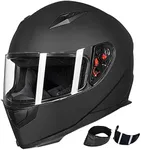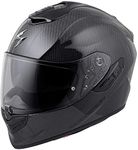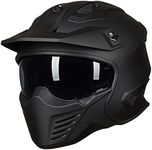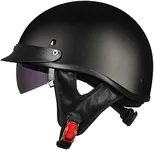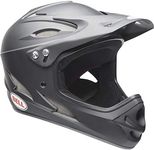Buying Guide for the Best Motorcycle Helmets
Choosing the right motorcycle helmet is crucial for your safety and comfort while riding. A helmet not only protects your head in case of an accident but also shields you from wind, debris, and weather. When shopping for a helmet, it's important to consider how and where you'll be riding, as well as your personal preferences for comfort and style. Understanding the key features will help you make an informed decision and ensure you get a helmet that fits your needs.Helmet TypeHelmet type refers to the overall design and coverage the helmet provides. The main types are full-face, modular (flip-up), open-face (3/4), and half helmets. Full-face helmets offer the most protection, covering your entire head and face, making them ideal for high-speed or long-distance riding. Modular helmets provide flexibility by allowing the chin bar to flip up, which is convenient for touring riders who want both protection and ease of use. Open-face helmets cover the top and sides of your head but leave your face exposed, offering a more open feel but less protection. Half helmets cover only the top of your head and are the lightest, but provide the least protection. Choose the type based on your riding style, comfort preferences, and the level of protection you want.
Safety CertificationSafety certification indicates that a helmet meets certain safety standards set by organizations such as DOT, ECE, or Snell. These certifications ensure the helmet has passed impact and durability tests. DOT is the standard in the United States, ECE is common in Europe, and Snell is a more rigorous, voluntary standard. When choosing a helmet, always look for at least one of these certifications to ensure basic safety. If you ride in different countries or participate in racing, check which certification is required or recommended for your activity.
Fit and ComfortFit and comfort are about how well the helmet sits on your head and how comfortable it feels during use. A helmet should fit snugly without being too tight, and it should not move around when you shake your head. Liners and padding play a big role in comfort, as do features like ventilation and weight. Helmets come in different shapes (round, oval, intermediate) to match different head shapes. To pick the right fit, measure your head circumference and try on different helmets, paying attention to pressure points and overall feel. Comfort is especially important for long rides, so prioritize a good fit.
VentilationVentilation refers to the airflow system built into the helmet to keep you cool and reduce fogging. Good ventilation is important for comfort, especially in hot weather or during long rides. Helmets can have multiple vents on the chin, top, and rear. More vents generally mean better airflow, but can also increase noise. If you ride in warm climates or tend to get hot, look for helmets with adjustable and well-placed vents. For colder climates, fewer vents may be preferable to keep you warm.
Visor/ShieldThe visor or shield is the clear or tinted screen that protects your eyes and face from wind, dust, and debris. Some helmets offer anti-fog or anti-scratch coatings, and others have sun visors that can be flipped down. The quality and features of the visor can affect your visibility and comfort. If you ride in varying light conditions, a helmet with a drop-down sun visor or quick-change visor system can be very useful. Consider your typical riding environment and whether you need extra protection from sun or glare.
WeightHelmet weight affects how comfortable the helmet feels, especially on long rides. Lighter helmets reduce neck fatigue but must still provide adequate protection. Weight varies depending on the materials used, such as polycarbonate, fiberglass, or carbon fiber. If you plan to ride for extended periods or have a sensitive neck, look for a lighter helmet that still meets safety standards. Try on different helmets to see what feels manageable for you.
Interior FeaturesInterior features include the helmet's padding, liner material, and whether the liner is removable and washable. Good padding improves comfort and fit, while moisture-wicking liners help keep you dry. Removable liners are convenient for cleaning, which is important if you ride often or in hot weather. If you value hygiene and comfort, look for helmets with high-quality, removable, and washable interiors.


